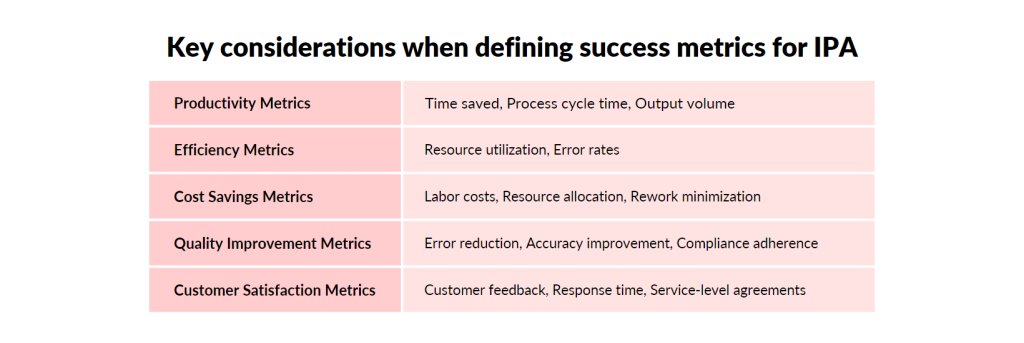In the exhilarating journey of implementing Intelligent Process Automation (IPA), we have explored the realms of building a compelling business case, designing robust solutions, and navigating the seas of change. Now, as we reach the final destination of our 7-series blog, it is time to unlock the key to sustained success – evaluating the impact of your IPA implementation.
Evaluating the success of your IPA initiatives is crucial for unlocking the full potential of automation. It allows you to measure performance, identify areas for improvement, and demonstrate the tangible benefits it brings to your organization. By enhancing productivity, streamlining operations, and driving cost savings, evaluating IPA’s impact paves the way for continuous improvement and transformation.
In this conclusive blog, we delve into the world of evaluating success in IPA implementation. We will uncover the metrics, techniques, and strategies that empower you to measure the transformative power of automation and its undeniable impact on your productivity, efficiency, and bottom line. Get ready to uncover the secrets of effective evaluation and unleash the full potential of your IPA initiatives.
Defining Success Metrics

To effectively evaluate the impact of Intelligent Process Automation (IPA), it is crucial to define and track key metrics that align with organizational goals and desired outcomes. These metrics provide valuable insights into the effectiveness of IPA implementation and its contribution to the organization’s success.
When determining success metrics, consider a range of factors that encompass different aspects of your business operations. Metrics related to productivity, such as time saved, process cycle time, or output volume, can shed light on the efficiency gains achieved through IPA. Evaluating efficiency metrics, such as resource utilization or error rates, helps identify areas where automation has streamlined operations and reduced manual effort.
Cost savings is another important metric to consider. Evaluate the impact of IPA on cost reduction, such as decreased labor costs, improved resource allocation, or minimized rework. Assessing the quality improvement achieved through IPA can be measured by metrics such as error reduction, improved accuracy, or compliance adherence.
Customer satisfaction is a vital aspect of IPA’s success. Metrics like customer feedback, response time, or service-level agreements can gauge the impact of automation on enhancing customer experiences. Aligning these metrics with organizational goals and desired outcomes ensures that evaluation focuses on the areas that matter most to your business.
By defining and consistently tracking these success metrics, organizations can effectively assess the impact of IPA and identify opportunities for further improvement and optimization.
Data Collection and Analysis
Collecting and analyzing relevant data is a critical step in evaluating the impact of Intelligent Process Automation (IPA) on your organization. It provides the necessary evidence to assess the effectiveness of IPA implementation and make informed decisions for continuous improvement.
To collect relevant data, organizations can leverage various sources, such as process logs, system reports, and user feedback. Process logs capture detailed information about process execution, highlighting bottlenecks, exceptions, and areas for optimization. System reports offer valuable insights into performance metrics, resource utilization, and the overall health of automated processes. User feedback, through surveys or interviews, provides subjective perspectives on user experiences and satisfaction.
Once the data is collected, it is essential to employ effective analysis techniques to derive meaningful insights. Statistical analysis can help identify patterns, trends, and correlations within the data, providing quantitative evidence of IPA’s impact. Data visualization techniques, such as charts, graphs, and dashboards, offer intuitive representations of data, making it easier to interpret and communicate insights to stakeholders.
By combining data collection and analysis, organizations can gain a comprehensive understanding of IPA’s impact and identify areas for improvement. It enables data-driven decision-making, fostering a culture of continuous improvement and transformation.
Identifying Areas for Improvement

Evaluating the success of Intelligent Process Automation (IPA) goes beyond measuring its impact; it also provides valuable insights for identifying areas for process optimization and further automation. By leveraging evaluation results, organizations can continuously enhance their IPA implementation and drive iterative improvements.
Process mapping is a valuable technique for visualizing the flow of processes and identifying areas that can benefit from optimization. Root cause analysis is another powerful tool for identifying areas for improvement. By delving deeper into the underlying causes of issues or performance gaps identified during evaluation, organizations can uncover the root causes and develop targeted solutions.
Continuous improvement methodologies, such as Lean or Six Sigma, provide structured frameworks for driving ongoing enhancements. By embracing a culture of continuous improvement and encouraging employees to contribute their insights and ideas, organizations can foster an environment where iterative enhancements to IPA implementation are continuously pursued.
An essential aspect of identifying areas for improvement is the establishment of a feedback loop. By soliciting feedback from stakeholders, employees, and end-users, organizations can gather valuable insights into their IPA implementation.
By leveraging techniques such as process mapping, root cause analysis, continuous improvement methodologies, and feedback loops, organizations can proactively identify areas for improvement in their IPA implementation. This iterative approach ensures that IPA remains a catalyst for continuous enhancement and drives the organization’s pursuit of operational excellence.
Demonstrating Tangible Impact
Effectively communicating the impact of Intelligent Process Automation (IPA) to stakeholders is crucial for gaining support and showcasing the value of automation initiatives. By employing strategies that highlight tangible results, organizations can effectively convey the transformative power of IPA implementation.
Before-and-after comparisons are another powerful tool for demonstrating the impact of IPA. By showcasing the improvements achieved through automation, such as reduced processing time, increased accuracy, or cost savings, organizations can paint a clear picture of the transformative effect of IPA on business operations. You can also create case-studies to showcase the impact of IPA in a more innovative manner.
ROI (Return on Investment) analysis is a quantitative approach that assesses the financial benefits of IPA implementation. By quantifying the cost savings, productivity gains, and efficiency improvements, organizations can present a compelling business case and demonstrate the tangible return on investment derived from automation.
In addition to data-driven approaches, storytelling, and narrative play a significant role in conveying the success of IPA implementation. By weaving a compelling narrative that showcases the challenges faced, the journey toward automation, and the positive outcomes achieved, organizations can capture the attention and engagement of stakeholders. Storytelling humanizes the impact of IPA, making it relatable and memorable.
When demonstrating the impact of IPA, it is essential to tailor the message to different stakeholders’ specific needs and interests. By presenting data, case studies, and narratives in a clear and concise manner, organizations can effectively communicate the value and success of IPA implementation, fostering support and buy-in from stakeholders.
Continuous Evaluation and Adaptation
Evaluating the impact of Intelligent Process Automation (IPA) is not a one-time event but an ongoing process. Continuous evaluation allows organizations to monitor the effectiveness of IPA implementation, identify emerging trends, and make timely adjustments to ensure continued success.
Feedback mechanisms play a crucial role in gathering insights from users and stakeholders. Regular feedback sessions, performance reviews, and user satisfaction surveys provide valuable input on the effectiveness of IPA and areas for improvement. This feedback serves as a catalyst for continuous improvement, guiding organizations in refining their automation strategies and addressing any concerns or challenges that arise.
In addition to feedback, organizations must stay attuned to the evolving business landscape and technological advancements. By monitoring industry trends, staying informed about emerging technologies, and adapting to changing needs, organizations can ensure that their IPA solutions remain relevant and effective.
A culture of continuous improvement and learning is essential for successful IPA implementation. It encourages teams to proactively seek opportunities for optimization, explore new possibilities, and embrace innovation.
Throughout the 7-series blog, “Unleashing the Power of Intelligent Process Automation: A Roadmap to Revolutionize Your Business,” we have explored the transformative potential of Intelligent Process Automation (IPA) and provided valuable insights and strategies for successful implementation. In this final blog, we focused on evaluating the success of IPA initiatives and measuring their impact.
Evaluating the success of IPA implementation is crucial for organizations to understand the true potential of automation, track performance, identify areas for improvement, and demonstrate the tangible benefits it brings. By defining success metrics, collecting and analyzing data, and continuously evaluating and adapting, organizations can ensure that their IPA initiatives deliver optimal results.
We have discussed the importance of fostering a culture of innovation, addressing employee concerns, communicating the vision and benefits, providing training and skill development, and maintaining a feedback loop. These strategies and techniques are key to preparing teams for change, maximizing the benefits of IPA, and driving a successful transformation.
By leveraging the best practices, avoiding common pitfalls, and embracing a continuous learning and improvement mindset, you can unlock the full potential of IPA and revolutionize your business.
We hope this series has provided you with a comprehensive roadmap to guide your IPA journey. Remember, automation is not just a one-time implementation; it is a continuous process of innovation and transformation. By staying informed, adapting to changing business needs, and embracing emerging technologies, you can continue to unleash the power of Intelligent Process Automation and propel your organization to new heights of success.










